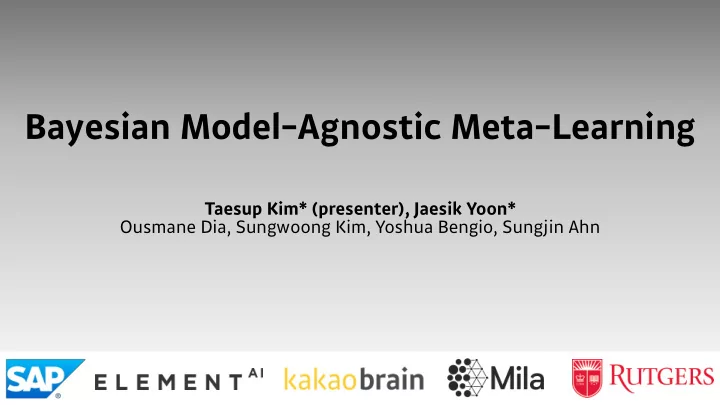

Bayesian Model-Agnostic Meta-Learning Taesup Kim* (presenter), Jaesik Yoon* Ousmane Dia, Sungwoong Kim, Yoshua Bengio, Sungjin Ahn
Model-Agnostic Meta-learning (MAML) “gradient-based meta-learning framework” meta-update task adaptation initial parameters
Model-Agnostic Meta-learning (MAML) For each task in a batch: Task adaptation Task Model Meta-update Initial Model
Gradient-Based Meta-Learning + “Bayesian” Robust to over!tting Safe/e'cient exploration Active learning Uncertainty
Lightweight Laplace Approximation for Meta-Adaptation (LLAMA) MAML LLAMA meta-update task adaptation
Gaussian Approximation Lightweight Laplace Approximation for Meta-Adaptation (LLAMA) meta-update task adaptation
Lightweight Laplace Approximation for Meta-Adaptation (LLAMA) meta-update task adaptation Gaussian Approximation No uncertainty for initial model
Lightweight Laplace Approximation for Meta-Adaptation (LLAMA) meta-update task adaptation Gaussian Approximation No uncertainty for initial model
MAML LLAMA BMAML Bayesian Model-Agnostic Meta-Learning (BMAML) point estimate Gaussian approx. complex multimodal meta-update task adaptation
meta-update task adaptation BMAML complex multimodal Meta-update Initial Model Bayesian meta-update Initial distribution For each task in a batch: Task adaptation Task Model Bayesian fast adaptation Task Distribution Bayesian Model-Agnostic Meta-Learning (BMAML)
Model-Agnostic Meta-Learning (MAML) Stein Variational Gradient Descent (SVGD) “gradient-based meta-learning framework” “particle-based posterior approximation” + Bayesian Fast Adaptation (BFA) θ 1 θ 4 θ 2 θ 3
“particle-based posterior approximation” Stein Variational Gradient Descent (SVGD) “backprop to initial model through deterministic SVGD particles” ∇ θ i log p ( θ i ) k ( θ i , θ j )
Bayesian Fast Adaptation (BFA) Meta-update Meta-loss Initial distribution
Bayesian Fast Adaptation (BFA) Task adaptation Task 2 posterior Task 1 posterior Task 3 posterior Initial distribution
Bayesian Meta-Update with Chaser Loss “extend uncertainty-awareness to meta-update” Chaser Leader Initial “Distance = Chaser Loss” current task posterior target task posterior
Bayesian Meta-Update with Chaser Loss Chaser Leader Initial “Distance = Chaser Loss” current task posterior target task posterior
Bayesian Meta-Update with Chaser Loss Chaser Initial For each task, - Compute CHASER PARTICLES 2 T t do Compute chaser Θ n τ ( Θ 0 ) = SVGD n ( Θ 0 ; D trn τ , α ) n + s n D Compute leader SVGD
Bayesian Meta-Update with Chaser Loss Chaser - Compute CHASER PARTICLES For each task, Initial - Compute LEADER PARTICLES Leader 0 D τ Compute chaser SVGD n 0 τ Compute leader Θ n + s ( Θ 0 ) = SVGD s ( Θ n τ ( Θ 0 ); D trn τ [ D val τ , α ) τ
For each task, - Compute LEADER PARTICLES - Compute CHASER LOSS Bayesian Meta-Update with Chaser Loss Chaser Leader Initial “Distance = Chaser Loss” - Compute CHASER PARTICLES M X X X d s ( Θ n τ k Θ n + s k θ n,m � θ n + s,m k 2 L BMAML ( Θ 0 ) = ) = 2 . τ τ τ τ ∈ T t τ ∈ T t m =1
Experiments Image Classification Active Learning Regression • prevent over!tting with better performance • evaluate e ectiveness of measured uncertainty
Experiments Reinforcement Learning • better policy exploration
See you at Poster “AB #15” (room 210 & 230)
Recommend
More recommend